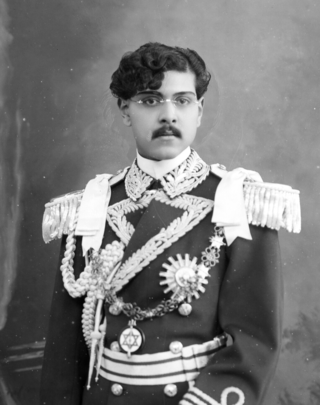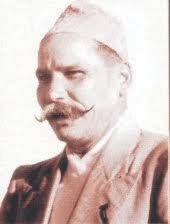
Tribhuvan Bir Bikram Shah Dev, was King of Nepal. Born in Kathmandu, the capital city of Nepal, he ascended to the throne at the age of five, upon the death of his father, Prithvi Bir Bikram Shah, and was crowned on 20 February 1913 at the Nasal Chowk, Hanuman Dhoka Palace in Kathmandu, with his mother acting as regent. At the time of his crowning, the position of monarch was largely ceremonial, with the real governing power residing with the Rana family.

The Nepali Congress is a social democratic political party in Nepal and the largest party in the country. The party has 870,106 members as of the party's 14th general convention in December 2021, making it the largest party by membership in Nepal. In June 2023, the party started online membership since the emergence of youth leaders in vital posts to attract youths to the party. The party is led by former prime minister, Sher Bahadur Deuba since the party's thirteenth general convention in 2016. The party won 89 seats in the 2022 general election and is currently the largest parliamentary group in the House of Representatives.

Subarna Shamsher Rana was a leading figure in the movement to overthrow the ruling Rana oligarchy and to establish democracy in Nepal. He was one of the three leaders of the Nepali Congress in the late 1940s, opposing his relatives, the Rana family, who held power in Nepal at the time.
Surya Prasad Upadhyaya was a Nepalese politician. Upadhyaya was a leader of the Nepal Democratic Congress, which merged with into the Nepali Congress in 1950.

Kunwar Indrajit Singh, popularly known as Dr. K.I. Singh or just K.I. Singh was a Nepali politician and revolutionary who served as the 20th Prime Minister of Nepal in 1957. He was a key member of the Nepali Congress for his role in organizing the 1951 Nepali Revolution, and was a leader in its militant wing, the Muktisena, and later refused to recognize the Delhi Accord and was forced to flee the country following a revolt he took part in. In 1955 he returned and formed the United Democratic Party, and following the installation of the Panchayat system he fought for its end, for which he was jailed. Following his release, he went into self-imposed exile, but eventually returned to Nepal and was elected a member to the Rastriya Panchayat. He became known as the "Robin Hood of the Himalayas", becoming an incredibly popular figure throughout the country.

General elections were held in Nepal from 18 February to 3 April 1959 to elect the 109 members of the first House of Representatives, the lower house of the Parliament of Nepal. They were held under the provisions of the 1959 constitution, which had been adopted on 12 February. More than 4.25 million people out of an overall population of about 8.55 million (1954) were eligible to vote. Voter turnout was 42.18%.

The Rastriya Panchayat was the legislature of the Kingdom of Nepal from during the panchayat era from 1962 to 1990. Following the 1960 coup by King Mahendra, the enactment of the Constitution of 1962, made the Rastriya Panchayat the supreme legislative body in the country, replacing the Parliament of Nepal.

The revolution of 1951 in Nepal, also referred to as Sat Salko Kranti, was a political movement against the direct rule by the Rana dynasty of Nepal which had lasted for 104 years.
The following lists events that happened during 1959 in the Kingdom of Nepal.
Delhi Accord was a tripartite agreement (verbal) in Delhi after mutual agreement between Ranas, Nepali congress party and King Tribhuban.

The Baburam Bhattarai cabinet was formed on 29 August 2011 after Baburam Bhattarai of UCPN (Maoist) was appointed as prime minister. The cabinet was expanded on 4 September, 15 September and 8 November 2011. The coalition government was formed with the United Democratic Madhesi Front and minor parties in the Constituent Assembly.

The Madhav Kumar Nepal cabinet was formed on 23 May 2009 after Madhav Kumar Nepal of the CPN (UML) was appointed as prime minister. His candidacy was supported by twenty of twenty five parties in the 1st Constituent Assembly. He took office with a three-member cabinet on 25 May 2009. Eight ministers were added from Nepali Congress and MJFN (Loktantrik) on 4 June.

The Jhala Nath Khanal cabinet was formed on 6 February 2011 after Jhala Nath Khanal of the CPN (UML) was appointed as prime minister. The cabinet was expanded on 11 April with members from his own party and on 4 May with members from coalition partners UCPN (Maoist) and Madheshi Jana Adhikar Forum, Nepal. The cabinet was reshuffled on 1 August 2011.
Rastriya Prajantantra Party (Samyukta) (Nepali: राष्ट्रिय प्रजातन्त्र पार्टी (संयुक्त)), literally the National Democratic Party (United) and abbreviated RPP (U), was a political party in Nepal. It was formed on 6 August 2017 by Pashupati Shamsher Jang Bahadur Rana after splitting from the Rastriya Prajatantra Party as the Rastriya Prajatantra Party (Democratic). On 31 January 2019, it merged with the Unified Rastriya Prajatantra Party (Nationalist), another splinter group of the Rastriya Prajatantra Party, to form Samyukta.

The Minister of Finance(or simply, the FinanceMinister, is the head of the Ministry of Finance of the Government of Nepal. One of the senior-most officers in the Federal Cabinet, the finance minister is responsible for the fiscal policy of the government. A key duty of the Finance Minister is to present the annual federal budget in Parliament, detailing the government's plan for taxation and spending in the coming financial year. Through the Budget, the finance minister also outlines allocations to all the ministries and departments. The Minister is assisted by the Minister of State for Finance and the junior Deputy Minister of Finance.

Bisheshwar Prasad Koirala formed the first elected government of Nepal on 27 May 1959. After the 1951 democratic movement, several transitional governments failed to hold the first general elections in the country until an interim government under Subarna SJB Rana held the 1959 general elections in two phases on 18 February and 3 April 1959. Nepali Congress gained a majority in the 1st House of Representatives of Nepal and Bishweshwar Prasad Koirala was elected as the parliamentary party leader of the Nepali Congress on 4 May 1959. On 16 May 1959, Koirala was invited by King Mahendra to form a government and the cabinet was formed on 27 May 1959. The cabinet was reshuffled just over a month later on 30 June 1959.

The Nepal Democratic Congress was a political party in Nepal established in 1948 by Subarna Shamsher and Mahabir Shamsher.

Nepali National Congress was a political party in Nepal that was founded in 1947. The party was founded to protest the Rana rule in Nepal. Dilli Raman Regmi, B. P. Koirala, Matrika Prasad Koirala, Ganesh Man Singh, Krishna Prasad Bhattarai, Mahendra Narayan Nidhi were founding members of the party.

Lalita Niwas land grab scam or Lalita Niwas land scam is a scam where the land ownership of government owned Lalita Niwas which houses the Official Residence of the Prime Minister of Nepal, central office of the Nepal Rastra Bank and other VIP residences, was illegally transferred by land brokers to big business groups of Nepal through collusion with land revenue officials, ministers, political leaders and secretaries at various ministries of Nepal. The land involved in the land grab scam was 114 ropanis which amounted to billions of Nepalese rupees.














